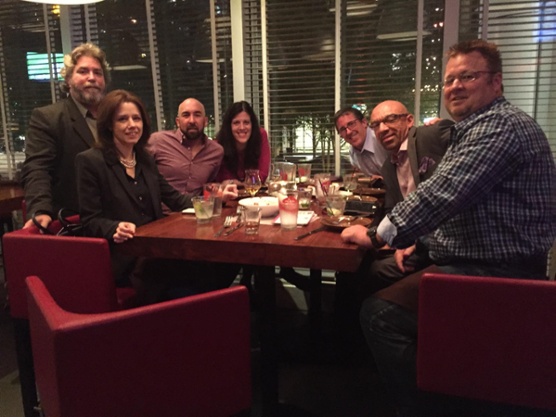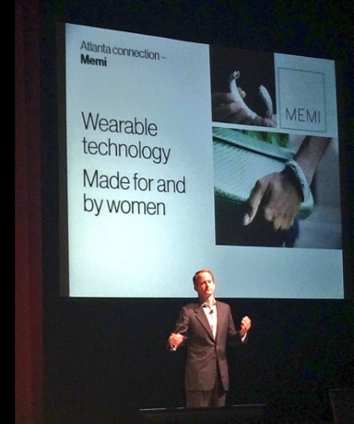On September 23 and 24, hundreds of leading global mobile marketing thought leaders gathered for the second annual MobilityLive! conference hosted by the Metro Atlanta Chamber of Commerce.
Day 2 of MobilityLive! kicked off with breakfast and networking in the foyer of the Woodruff Art Center followed by a welcome session by Mike Zeto and David Christopher of AT&T Mobility and a Fireside Chat: Getting to Tomorrow – Making Mobile Work in the Real World led by The
Coca-Cola Company’s Group Director of Global Connections Tom Daly. Tom led SAP’s Josh Waddell, Cisco’s Doug Webster, Delta Air Line’s Rhonda Crawford and The Weather Channel’s Chris McClellen in a panel discussion around the impact of mobile on customers and how these brands are creating new experiences designed with the mobile environment in mind. They also talked about the types of new technologies each of the brands were investing in, with Tom Daly quipping: “Test and fail to learn and scale.”
After the morning’s fireside chat, I headed off to Opera for the Mobile Application Development Experts Panel moderated by Mercurium’s Rupen Patel. Rupen was joined by Pratik Patel from TripLingo, Blake Byrnes from BlueFletch, SAP’s Andrew Lunde, Myriad Mobile’s Jake Joraanstad and Nick Hunter from pureIntegration. This was an interesting panel that quickly became a lengthy discussion around native/cross platform/hybrid app development. While the majority of the panelist seemed to favor cross platform app development using HTML 5, Myriad Mobile’s representative was the only panelist that made the hardline argument for native-only app development. To his point, what mobile enthusiast would rather code for cross platform when they can develop for the device they are most passionate about? While understandably, there are valid business reasons for wanting to go with a cross platform app, the long-term value of going native is significantly higher for a brand whose reputation hinges on user experience and complex functionality.

Next, I headed over to The W Hotel for Think Outside the Bricks and Mortar: Understanding How Mobile is Moving Retailers. About 10 minutes in, I realized I was in a different session – New Revenue Models: What is Beyond Post-Paid, Pre-Paid and App/Feature Fees. The session was moderated by Jorge Fuenzalida of inCode Consulting. He was joined by Mark Lowenstein of Mobile Ecosystem, Kevin Smithen from Macquarie Group and Christopher Hanna from Cox Communications. The group discussed how the mobile service business is changing based on the evolving industry and what new revenue streams would emerge in the future.
After breaking for lunch, we headed back to The W Hotel for Expanding the Reach of Mobility Through Education where my friend Michael Becker of mCordis was a panelist. Moderated by Scott Shamp, Director of the New Media Institute at The University of Georgia, and joined by Dr. Humayun Zafar, Assistant Professor of Information Security and Assurance at Kennesaw State University, and Jeff Evans, Director of the Info and Communication Lab (ICL) at GA Tech Research Institute, the panel had a spirited discussion on the role technology plays in education, from toddler age on up through professional education.
The panel acknowledged that higher ed is often slow to embrace new technologies and agreed that it is their ultimate mission to instill the value of life-long learning in students. Where the panelist differed is the role technology plays in the classroom. On the one side, Jeff advocated for the importance of having students learn using the tools they are comfortable with – tablets, mobile phones, etc…. whereas Michael argued that the technology wasn’t what mattered – whether students used technology or not, they really needed to be prepared as citizens of society to enter the workforce and that education wasn’t meant to make the students comfortable, but rather to challenge them. As long as the desire for learning and the ability to learn was imparted upon the student, educators need not worry as much as to how students learn.
During this session, the topic of data ownership and privacy came up again. This topic is of huge concern and should be paid close attention to by all of us whose personal data is mined and used to develop insights on consumer behavior.
This applies to the majority of us – our phones broadcast our movements at any given time; our online activity determines what ads are served up to us; social media keeps tabs on our activities, etc. As individuals, we should own our own data, but as app users and web surfers, we often sign away our rights to keep this data private each time we accept a user agreement in order to play a game or interact with our social circle.
As adults, we know there is a data transaction associated with our online activity. But what about the activities of our children? In a side discussion with friends during the conference, we thought about the implications of having our kids’ online activities monitored. While my child might watch Elmo videos and play with Looney Tunes apps, another child might play math games and use apps designed to foster a love of science. Will marketers and advertizers use that data one day to determine whether or not my child gets Rolling Stone and the other child get Popular Science? Will higher ed institutions use this data to determine whether or not my child is targeted for a University of Phoenix rather than a Georgia Tech? There are a lot of things we as a society haven’t considered when it comes to “big data.”
The theme continued in the last session of the day: Wearables: The Human Connection and Whose Data Is It? Moderated by Jamie Turner of 60 Second Communications who was joined by Justin Butler from Misfit Wearables, Leslie Pierson, Co-Founder of Memi and Dr. Maribeth Gandy, Director of IMTC and the Wearable Computing Center at Georgia Tech, the panel discussed the various kinds of wearables that are now on or coming to the market, the struggle between fashion first vs. technology first in wearable device design, and of course, who owns the data generated by the wearable.
Justin openly acknowledged that Misfit Wearables is a data company and quipped that he’s more concerned with his social security number and banking information being available than he is about the public availability of his toe disease (medical records). However, Dr. Gandy considered the ramifications of public access to health records and whether mined information might be used to discriminate against certain medical conditions such as denying housing or employment to an HIV patient. It’s easy to see why the concept of big data isn’t scary to many – because we are generally good people who don’t think about the corrupt ways in which our personal data could be used against us. But as USA Today reported on September 24, 43 percent of companies have experienced data security breaches – now is a good of a time as any to think about the possibilities.

The wearables panel was one of the best of the day, and I’m very excited about Memi coming to market in the spring. Designed “for women by women,” the Bluetooth-enabled bracelets allow the wearer to program the device to vibrate each time you receive a call from a favorite phone number, or have a calendar alert or set an alarm. It frees the wearer from having to carry their phone in-hand or dig for a phone in the bottom of a handbag each time it rings. As a lover of big purses, this is very appealing to me. (I am not paid by Memi for this plug, but if they’d like to give me a free one, I would happily wear it!)
Dr. Gandy spoke about the various research and development projects happening at Georgia Tech in the wearable space – for instance, wearables for service dogs that can assist first responders in how to take action after disasters or provide medical attention for someone dependent on their service animal. Very cool stuff!
Later that evening, a few old and new friends got together to unwind after the close of the conference. We talked more about our favorite sessions and continued the discussion of mobile marketing and data ownership and privacy.
Overall, I think the conference was well worth the $150 ticket price, and that the Metro Atlanta Chamber of Commerce did well in spreading the message that Atlanta is a very tech-savvy city poised to lead in the area of mobility. The opportunity to hear from experts in the field and network with some of the biggest names in mobile was great for a business development person like myself who is new to the mobile space, and I enjoyed seeing into the issues that will shape the future of the mobile industry. I am sure MobilityLive! 2015 will bring more interesting panels and new topics of interest for our industry.

